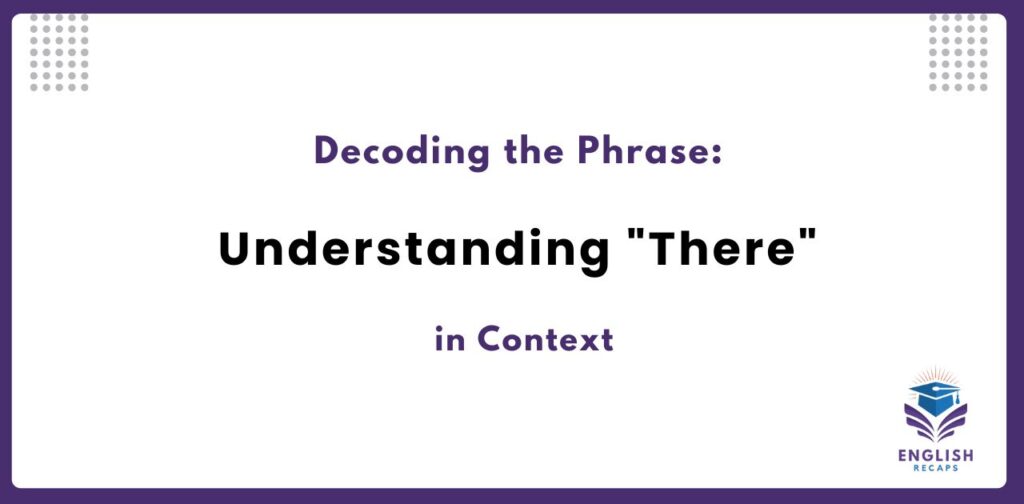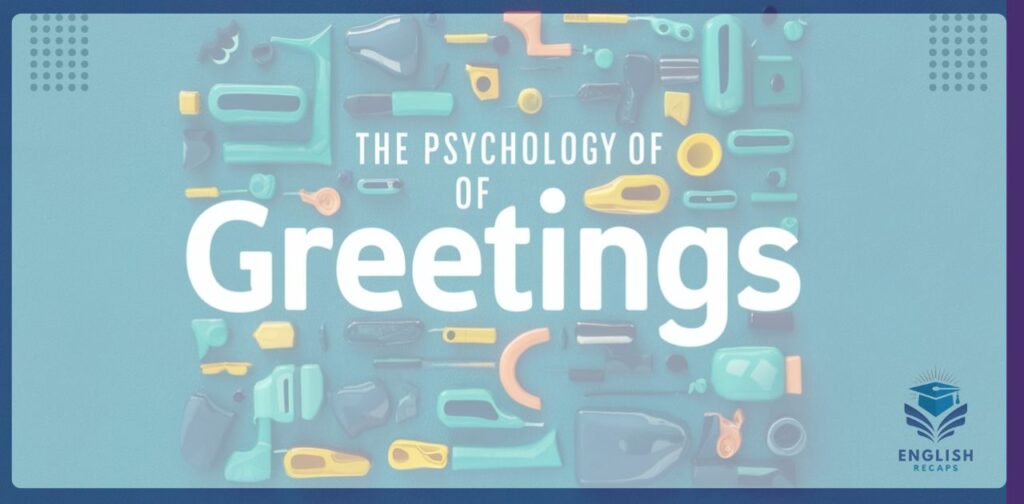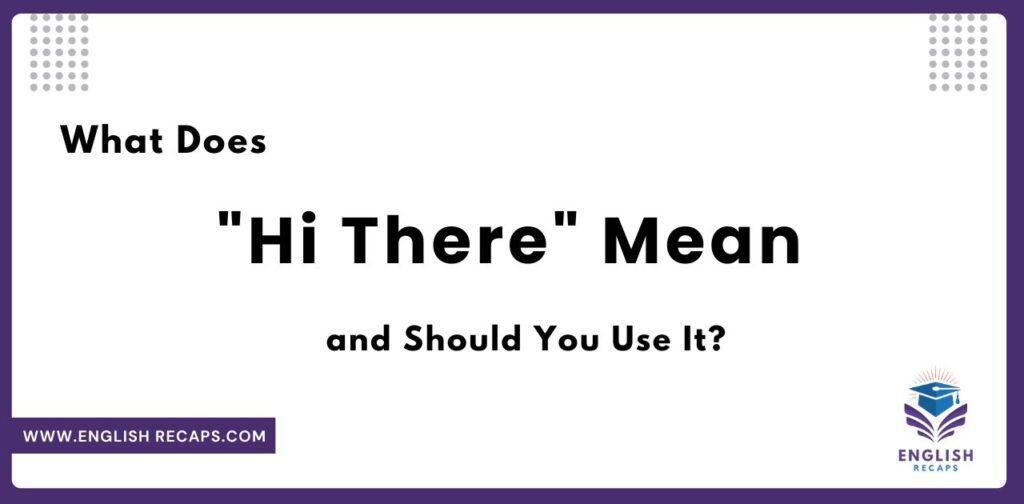Ever caught yourself wondering if “Hi there” is the right way to start a conversation? You’re not alone. This friendly greeting has become a go-to for many, but is it always appropriate?
"Hi there" is a casual way to say hello. It's like giving your words a friendly hug. The "there" doesn't point to a place it's just there to make things warmer.
But when should you use it? Is it too casual for work? Too impersonal for friends? In this article, we’ll break down what “Hi there” really means and when it’s best to use it. We’ll explore its casual charm, potential pitfalls, and how to navigate the sometimes tricky world of greetings.
So, ready to become a “Hi there” pro? Let’s dive in!
The Casual Origins and Usage of “Hi There”
Picture this: You’re walking down the street and spot a familiar face. Without thinking, you blurt out, “Hi there!” It feels natural, doesn’t it? That’s because “Hi there” has its roots in casual, everyday interactions. It’s the linguistic equivalent of a friendly wave or a quick nod.
But where did this greeting come from? While pinpointing the exact origin is tricky, “Hi there” gained popularity in the mid-20th century as part of a broader trend towards more relaxed communication. It’s like language decided to loosen its tie and kick off its shoes.
The beauty of “Hi there” lies in its versatility. It’s not just a greeting; it’s a mood-setter. When you use it, you’re essentially saying, “Hey, I’m approachable and friendly. Let’s chat!” It’s perfect for those moments when you want to be warm but not overly familiar.
Interestingly, “Hi there” doesn’t always follow the usual rules of “there” in language. You might think it’s used to address someone at a distance, but that’s not always the case. You could be standing right next to someone and still greet them with a cheerful “Hi there!”
Decoding the Phrase: Understanding “There” in Context

So what’s the deal with that “there”? It’s not pointing to a specific location like in “The book is over there.” Instead, it’s more of a verbal garnish, adding a dash of friendliness to your “Hi.”
How “There” Enhances the Greeting
Think of “there” as the secret sauce in this greeting sandwich. It takes a simple “Hi” and transforms it into something more engaging. It’s like the difference between a plain handshake and one with a warm smile; that little extra goes a long way.
The “there” in “Hi there” serves a few purposes:
- It softens the greeting, making it feel less abrupt.
- It adds a touch of familiarity, even if you’re meeting someone for the first time.
- It can express pleasant surprise, like when you bump into an old friend unexpectedly.
Examples of “Hi There” in Spoken English
Let’s eavesdrop on a few conversations to see “Hi there” in action:
- At a party: “Oh, hi there! I didn’t expect to see you here. How’ve you been?”
- In a shop: “Hi there! Can I help you find anything today?”
- On a video call: “Hi there! Thanks for joining the meeting. How’s everything on your end?”
Notice how in each case, “Hi there” sets a friendly, approachable tone right from the start.
Appropriateness in Conversation: When to Use “Hi There”
Now, here’s where things get a bit tricky. “Hi there” is like your favorite comfy t-shirt; perfect for hanging out with friends, but maybe not the best choice for a job interview. Let’s break down when it’s a great fit and when you might want to opt for something else.
Green Light Situations for “Hi There”:
- Casual social gatherings
- Informal work settings (like chatting with colleagues you know well)
- Customer service interactions (it’s friendly without being overly familiar)
- Social media comments or messages
- Meeting someone new in a relaxed setting
Proceed with Caution:
- First-time business emails (unless you know the company culture is super casual)
- Formal events or meetings
- When addressing someone in a position of authority you don’t know well
Red Light – Avoid Using “Hi There”:
- Formal written communication (like cover letters or legal documents)
- Very serious or somber situations
- When a more respectful or distant greeting is expected (like “Dear Professor” or “Good morning, Your Honor”)
Remember, context is key. If you’re unsure, it’s often better to err on the side of formality and then adjust based on the other person’s response.
Don’t miss out read this blog: Is It Correct to Say “How Is It Going?”: Casual American US English Greetings
The Nuances of Informal Vs. Formal Greetings
Let’s face it; navigating between informal and formal communication can feel like walking a tightrope sometimes. “Hi there” sits firmly on the informal side of things, but that doesn’t mean it’s always inappropriate in professional settings.
Impact of “Hi There” in Professional Settings
In today’s workplace, especially in industries like tech or creative fields, the lines between formal and informal communication are blurring. “Hi there” can work well in many professional situations, particularly in internal communication or with clients you have a good rapport with.
However, it’s crucial to read the room (or the email thread). In more traditional or conservative industries, sticking to “Hello” or “Good morning” might be a safer bet, at least initially.
Choosing Greetings Based on Relationship and Setting
Think of greetings as part of your communication wardrobe. Just like you wouldn’t wear flip-flops to a black-tie event, you need to match your greeting to the occasion and your relationship with the other person.
Here’s a quick guide:
- Close colleagues or work friends: “Hi there” is usually fine
- New clients or business contacts: Start formal (“Hello” or “Dear [Name]”) and adjust based on their response
- Higher-ups or VIPs: Err on the side of formality unless they’ve used casual language with you before
- Team emails: “Hi there, team” can work well to set a friendly, collaborative tone
Remember, it’s always easier to start formal and become more casual than the other way around.
Responding to “Hi There”: Tips for Crafting Your Reply
So someone’s greeted you with a cheery “Hi there!” – now what? Your response can set the tone for the rest of the conversation, so it’s worth giving it some thought.
Here are some ideas:
- Mirror their greeting: “Hi there to you too!” (shows you’re on the same wavelength)
- Keep it simple: “Hey! How’s it going?” (friendly and opens up the conversation)
- Add some enthusiasm: “Well hi there! Great to see/hear from you!” (especially good for people you’re happy to connect with)
- In writing, you might say: “Hi there! Thanks for reaching out.” (acknowledges their greeting and shows you’re engaged)
The key is to match or slightly adjust the level of formality they’ve set. If they’ve opened with a casual “Hi there,” it’s usually safe to respond in kind.
Tone and Intention: Is “Hi There” Flirty or Friendly?
Ah, the eternal question; are they just being nice, or is there more to it? The truth is, “Hi there” itself is neutral. It’s all about the delivery and context.
In most cases, “Hi there” is simply a friendly, approachable greeting. But let’s be real; anything can sound flirty with the right tone of voice and a well-timed wink.
Here’s how to tell the difference:
Friendly “Hi There”:
- Used in general social or professional settings
- Typically accompanied by a regular smile and neutral body language
- Often followed by general pleasantries or getting down to business
Potentially Flirty “Hi There”:
- Might be accompanied by a coy smile or prolonged eye contact
- Could be said in a softer or more playful tone
- Might be followed by more personal questions or compliments
Remember, if you’re unsure, it’s best to assume the greeting is simply friendly unless there are other clear signs of flirting.
How do you actually say “hello” and “hi” in English?
Evolution of Greetings: “Hi There” from Past to Present
Language is always evolving, and greetings are no exception. “Hi there” has been on quite a journey over the years.
In the early 20th century, greetings tended to be more formal. “How do you do?” and “Good day” were the norm. But as society became more casual, so did our hellos.
“Hi there” gained traction in the mid-20th century, riding the wave of informality that came with social changes and the rise of youth culture. It was casual without being too slangy; the perfect middle ground.
Fast forward to today, and “Hi there” has found new life in the digital age. It’s a staple in emails, chat messages, and customer service interactions. Why? Because it strikes that balance between friendly and professional that works so well in many online contexts.
Interestingly, the rise of global communication has also influenced how we use “Hi there.” In international business, it can be a safe choice; friendly enough to be welcoming, but not so informal as to be inappropriate in cultures where formality is highly valued.
How to say hello on the phone, in a text, or email
Here’s how you can say “hello” depending on the context:
1. On the Phone:
- “Hello” – This is the standard way to answer or greet someone on the phone.
- “Hi, this is [Your Name]” – A polite introduction when calling someone.
- “Good morning/afternoon” – Adds a more formal tone, often used in professional settings.
2. In a Text:
- “Hey” – Casual and friendly, often used between friends.
- “Hi [Name]” – Simple and slightly formal.
- “Hello” – Neutral and can work for both casual and formal messages.
3. In an Email:
- “Dear [Name],” – Formal, often used in professional correspondence.
- “Hi [Name],” – Polite but less formal, appropriate for work or semi-casual emails.
- “Hello [Name],” – Neutral and professional, suitable for many contexts.
The Future of “Hi There” and Casual Greetings
As we look to the future, what’s in store for “Hi there” and greetings like it? With the continued blending of our personal and professional lives, especially in the age of remote work, casual greetings are likely to become even more common.
However, we’re also seeing a rise in personalized communication. AI and data analytics are making it possible to tailor greetings to individual preferences. Maybe in the future, our devices will suggest the perfect greeting based on our relationship with the recipient and the context of the message.
For now, “Hi there” remains a versatile, friendly option in our greeting repertoire. Whether it sticks around for decades to come or evolves into something new, the spirit of warm, approachable communication it represents is likely here to stay.
Crafting the Perfect Greeting: Beyond “Hi There”
While “Hi there” is a great all-rounder, it’s always good to have a few alternatives up your sleeve. Here are some other casual greetings and when they might work best:
- “Hey”: Super casual, best for friends or very informal settings
- “Hello”: A bit more formal than “Hi there,” good for most professional situations
- “Howdy”: Adds a touch of folksy charm, great for creating a warm, down-to-earth vibe
- “Greetings”: Slightly quirky, can be fun for creative or tech-oriented crowds
- “Good morning/afternoon/evening”: Time-specific and a touch more formal, suitable for a wide range of situations
The key is to build a repertoire of greetings and learn to read the room (or the email thread) to choose the most appropriate one.
Cultural Considerations in Greetings
It’s important to remember that greetings can vary widely across cultures. While “Hi there” is generally well-received in English-speaking countries, it might not translate well in more formal cultures or in non-English speaking contexts.
For international communication, it’s often best to start more formal and take cues from the other person. A simple “Hello” or “Greetings” might be a safer bet until you’ve established the appropriate level of formality.
The Psychology of Greetings

Have you ever wondered why we put so much thought into something as simple as saying hello? There’s actually some interesting psychology behind greetings.
Greetings serve several important social functions:
- They signal the start of an interaction
- They help establish the tone of the conversation
- They can reinforce social bonds and hierarchies
- They play a role in creating first impressions
When we use a casual greeting like “Hi there,” we’re subconsciously sending signals about the kind of interaction we want to have; friendly, relaxed, and open.
Don’t miss out to read this blog: 21 Other Ways to Say “Have a Great Weekend” in an Email
The Impact of Technology on Greetings
The digital age has transformed how we communicate, and greetings haven’t been left behind. “Hi there” has found new life in the world of online communication.
In emails, it strikes a balance between the formality of “Dear” and the potential over-familiarity of “Hey.” In chat applications and messaging platforms, it’s a friendly opener that works for a wide range of relationships.
However, the rise of emoji and GIFs has added a new dimension to digital greetings. Now, a simple “Hi there” can be accompanied by a waving hand emoji or a friendly GIF, adding visual emphasis to the greeting’s warm tone.
Mastering the Art of the Greeting
At the end of the day, choosing the right greeting is about more than just words; it’s about connecting with people. Whether you go with “Hi there” or another greeting, the most important thing is to be genuine and considerate.
Here are some final tips for greeting mastery:
- Be aware of your audience and context
- Pay attention to how others greet you and mirror when appropriate
- Don’t be afraid to adjust your style as you get to know someone
- Remember that a warm tone and friendly body language can enhance any greeting
- When in doubt, err on the side of slightly more formal, then adjust as needed
Whether you’re saying hello to a friend, greeting a new client, or starting a conversation with a stranger, the right greeting can set the stage for a positive interaction. So go ahead, embrace the friendly versatility of “Hi there” when it fits, and don’t be afraid to mix it up when the situation calls for something different.
Summary
“Hi there” is a friendly, casual greeting that’s become popular in everyday conversations. It adds warmth to a simple “Hi” without being too formal. While it’s great for casual settings and with friends, it might not always fit in more formal situations. The key is knowing when and where to use it. This article explores the meaning behind “Hi there,” its appropriate uses, and how it’s evolved over time. We’ve also looked at how to respond to it and alternatives for different contexts. Remember, the best greeting is one that matches the situation and makes both you and the other person comfortable.
FAQ’s
How do you respond to hi there?
You can respond to “Hi there” in several ways:
- “Hi there to you too!”
- “Hey! How’s it going?”
- “Hello! Nice to see you.”
- “Hi! What’s new?”
The key is to match the friendly tone while considering the context of your interaction.
Is it polite to say “hi there”?
Yes, “Hi there” is generally considered polite in casual and semi-formal settings. It’s friendly and approachable. However, in very formal situations or when addressing someone in a position of authority, a more formal greeting might be more appropriate.
What is the difference between hi and hi there?
“Hi” is a simple, straightforward greeting. “Hi there” adds a touch of warmth and friendliness. The “there” doesn’t refer to a specific place but serves to make the greeting feel more personal and engaging.
What does hey there mean in a text?
In a text, “Hey there” is similar to “Hi there.” It’s a casual, friendly way to start a conversation. It often implies a positive mood and openness to chat. The sender is trying to create a warm, approachable tone.
Is “hi there” flirty?
“Hi there” isn’t inherently flirty it’s usually just friendly. However, like any greeting, it can be made flirty through tone of voice, body language, or context. If accompanied by a wink emoji in a text or said with a flirtatious tone in person, it could take on a flirty meaning.
What do you say after hi there?
After “Hi there,” you can follow up with:
- “How are you doing?”
- “It’s great to see you!”
- “What’s new with you?”
- “How’s your day going?”
Or, if appropriate, get straight to the purpose of your conversation: “I wanted to ask you about…”
The follow-up often depends on your relationship with the person and the context of your interaction.
Read More Related English Improving Blogs:
- 15+ Other Ways to Say “I Look Forward to Working With You”
- 18 Synonyms for “Including But Not Limited to”


